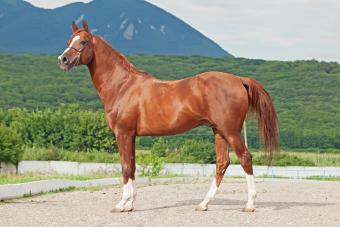
Horses can live into their 30s, but their relatively short lives are full of rapid changes. From the time a horse is born until their last days, they go through six distinct life stages. Each phase has unique characteristics, milestones, and needs. This free, printable horse life cycle shows how a horse develops from conception to old age.
Life Cycle Printable
Horses move through unique stages of life as they reach different developmental milestones. Click on the life cycle image to download and print for use at home or in the classroom. Consult the Adobe guide if you have any trouble accessing the printable file.
Horse Pregnancy and Birth
The horse gestation period begins as soon as a mare becomes pregnant or conceives a baby.
- A mare's pregnancy can last anywhere from 320 to 370 days but averages 340 days, or a little more than 11 months.
- Experts divide their gestation timeline into trimesters, similar to a human's.
-
A veterinarian can determine the sex of the foal through fetal sexing between days 120 and 150.
- At 150 days, the horse fetus weighs about 2 pounds but looks like a very tiny horse.
- Mares begin to look pregnant around 250 days.
Foaling
Foaling is the term used to describe a mare giving birth. About a week before foaling, the mare will prefer to be alone and may show signs of discomfort.
- A horse will begin "waxing," a term used for the collecting of colostrum on a mare's teats, approximately one to four days before foaling.
- Mares typically foal on their own, and the umbilical cord severs by itself shortly after birth.
Stages of Life
At each stage of life, horses have unique needs and experience different physical changes.
Foal

From the time they are born until they stop nursing from their mother, baby horses are called foals.
- Foals start nursing within two hours of birth.
- They need colostrum from their mothers' milk within the first six to 12 hours after birth due to an increased risk of respiratory diseases and diarrhea.
- This horse life stage consumes 15 to 25 percent of their body weight in milk daily.
- They nurse three to five times per hour.
- Foals remain close to their mother.
- They can start eating small amounts of foal feed around 2 months of age.
Weanling
Foals typically wean, or stop nursing from their mother, around the age of 3 to 6 months. A foal may be referred to as a weanling after the time they are weaned until 1 year of age.
- Weaning can be stressful for some foals.
- Foals this age need a good balance of high-quality proteins, calories, calcium, and phosphorus for proper growth.
- By six months, weanlings should weigh about half of their expected adult weight and reach about three-fourths of their expected height.
- Healthy weanlings only gain about 1 pound per day.
- They need regular exercise for muscle development.
- Vaccinations are given at around 8 months of age.
Yearling
From the time a horse turns 1 to the time it turns 2, it is called a yearling.
- Yearlings may look unbalanced as they go through growth spurts.
- During this stage, they near their mature height, and their bodies start to fill out.
- These juvenile horses are inquisitive in nature.
- Yearlings need a lot of water.
Adolescent
From age 2 to age 3, horses are considered adolescents.
- Horses reach puberty at this age.
- The growth rate slows down.
- A female is called a filly, and an ungelded male is called a colt.
- This is the ideal time for training, as they learn quickly.
Adult
Most horses are considered adults once they reach age 4, and their growth is complete.
- Females are now called mares, and males are called stallions or geldings.
- Adult horses need an annual dental checkup and exam.
- They can start breeding at this age.
- Adult horses should eat about 2 percent of their body weight daily in roughage or forage.
Senior

While the senior years for a horse can start around the age of 15, many today say horses aren't seniors until they reach age 20.
- A 20-year-old horse is comparable to a human at age 60.
- Senior horses should be checked over daily because they can develop health problems quickly and may need medicine or pain management.
- Feed for this life stage should be soft hay.
- Expect to see increases in either weight loss or weight gain.
- Hooves need daily cleaning.
- Senior horses experience reduced ability to regulate body temperature and will need proper shelter.
The Equine Life Cycle
From birth to death, the life cycle of a horse is marked by distinct periods of growth and maturation. Understanding growth, development, and needs at each stage of life can help you better care for or work with horses.







